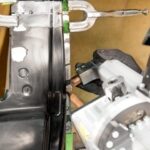The dreaded check engine light has illuminated, and your OBDII scanner reveals the error code P0508. What does this mean, and how serious is it? This article will delve into the P0508 code, explaining its causes, symptoms, and diagnostic procedures.
The P0508 code signifies a problem with the Idle Air Control (IAC) circuit, specifically indicating a lower than expected value. This system is crucial for regulating your engine’s idle speed. Understanding its function is key to comprehending the P0508 error.
How the Idle Air Control System Works
The IAC system utilizes a linear servomotor to control a plunger. This plunger regulates the airflow bypassing the throttle plate and entering the intake manifold. This bypass airflow is essential for maintaining a stable engine idle when the throttle plate is closed. Without sufficient air, the engine would stall.
The IAC valve constantly adjusts, controlled by the Powertrain Control Module (PCM). The PCM uses data from various sensors, including the oxygen sensor and throttle position sensor, to determine the precise amount of bypass airflow needed. It achieves this by adjusting the voltage and ground signals to the IAC valve. When the actual engine RPM deviates from the PCM’s programmed parameters, the P0508 code is triggered, and the check engine light may illuminate.
Symptoms of a P0508 Code
A faulty IAC system can lead to noticeable driving issues. Common symptoms associated with a P0508 code include:
- High or fluctuating idle speed: The engine may race or rev erratically while idling.
- Engine stalling: The engine may stall frequently, particularly when coming to a stop or idling.
- Unusual noises from the throttle body: A hissing or whistling sound may indicate a vacuum leak, often related to the IAC system.
- Illuminated check engine light: The most obvious symptom is the activation of the check engine light on your dashboard.
Common Causes of a P0508 Code
Several factors can contribute to a P0508 error code. The most prevalent causes include:
- Faulty IAC valve: A malfunctioning IAC valve is the most likely culprit. The valve may be stuck, clogged, or electrically faulty.
- Vacuum leaks: Leaks in the engine’s vacuum system can disrupt airflow and trigger the P0508 code.
- Wiring or connector issues: Damaged, corroded, or loose wiring and connectors in the IAC circuit can disrupt communication between the PCM and the IAC valve.
- Carbon buildup: Accumulated carbon deposits in the throttle body or IAC valve can restrict airflow and hinder proper function.
- PCM malfunction: While less common, a faulty PCM or a programming error can also cause a P0508 code.
Diagnosing and Repairing a P0508 Code
Diagnosing a P0508 code requires specialized tools like a diagnostic scanner and a digital multimeter. Here’s a general approach:
- Consult technical service bulletins (TSBs): Check for known issues and manufacturer-recommended fixes for your specific vehicle model.
- Inspect wiring and connectors: Examine the IAC system wiring and connectors for damage, corrosion, or looseness. Repair or replace as needed.
- Check for vacuum leaks: Inspect vacuum hoses and components for leaks. Use a smoke machine or a spray bottle with soapy water to locate leaks.
- Test the IAC valve: Use a multimeter to test the IAC valve’s resistance and electrical connections according to manufacturer specifications.
- Clean the throttle body and IAC valve: Remove carbon buildup from the throttle body and IAC valve using a specialized cleaner.
- Replace the IAC valve: If testing reveals a faulty IAC valve, replace it with a new one.
- Check the PCM: If all other components check out, diagnose the PCM for potential malfunctions or programming errors.
Remember to disconnect related controllers before testing circuit resistance with a multimeter.
Conclusion
The P0508 error code indicates a problem within the idle air control system. Addressing this issue promptly is crucial to prevent further engine problems and ensure smooth vehicle operation. By understanding the underlying causes and diagnostic procedures, you can effectively troubleshoot and resolve the P0508 code, restoring your vehicle’s performance and fuel efficiency.

